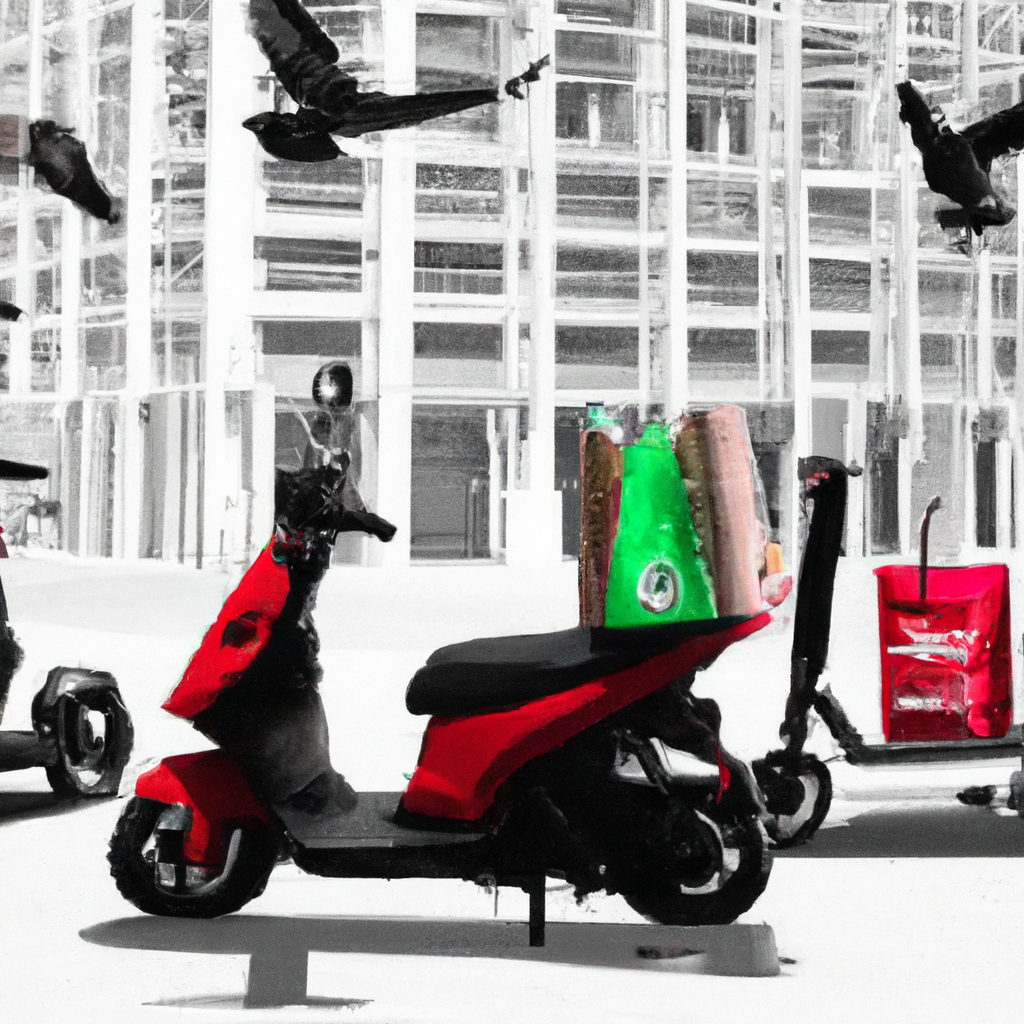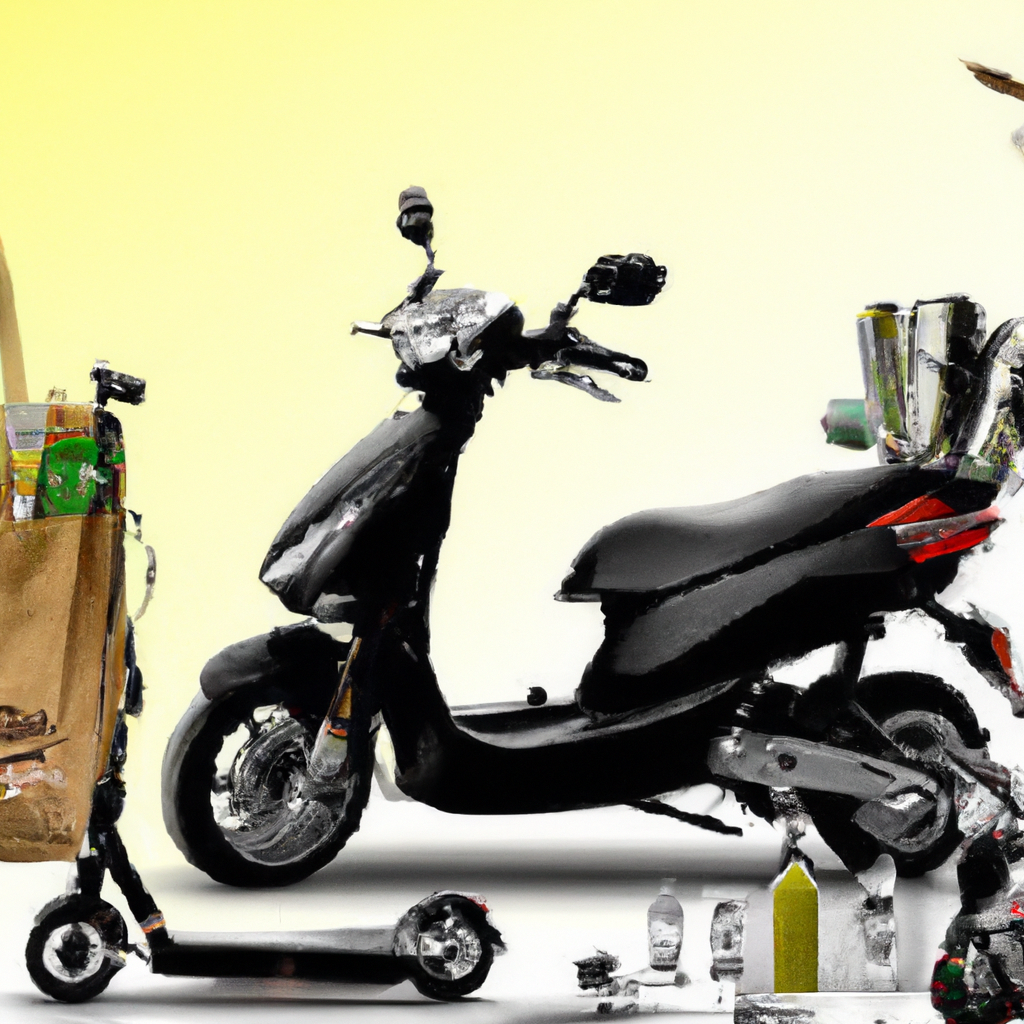If you’re searching for a convenient and eco-friendly way to deliver food, look no further than electric scooters. These compact and agile vehicles have taken the streets by storm, revolutionizing urban transportation. But can they also be used for food delivery services? The answer is a resounding yes! With their ability to maneuver through traffic and reach even the most congested areas, electric scooters offer a practical solution for delivering scrumptious meals to hungry customers. In this article, we explore the advantages of using electric scooters for food delivery and delve into the potential challenges these services may face. So buckle up and let’s explore the thrilling world of electric scooter food delivery! Yes, they definitely can! In fact, more and more food delivery services are opting for electric scooters as a sustainable and efficient mode of transportation. Electric scooters offer several benefits that make them an attractive option for food delivery businesses. Let’s take a closer look at these benefits and also address the challenges that come with using electric scooters for food delivery services. Additionally, we will discuss the factors that need to be considered when using electric scooters, provide examples of food delivery services already using them, share best practices for their use, and discuss the future of electric scooters in food delivery services.

Benefits of Using Electric Scooters for Food Delivery Services
Eco-Friendly Alternative to Gasoline Vehicles
One of the primary advantages of using electric scooters for food delivery services is their eco-friendly nature. Unlike gasoline vehicles, electric scooters produce zero emissions, helping to reduce air pollution and combat climate change. By using electric scooters, food delivery services can contribute to creating a cleaner and greener environment.
Lower Operational Costs
Operating an electric scooter is significantly cheaper compared to a traditional gasoline-powered vehicle. Electric scooters can be charged using electricity, which is much more affordable than gasoline. This helps food delivery services save a significant amount of money on fuel expenses, allowing them to allocate those resources to other areas of their business.
Faster Delivery Times
Electric scooters are known for their agility and speed. With their compact size and maneuverability, they can navigate through traffic and busy urban areas more efficiently than larger vehicles. This results in faster delivery times, allowing food delivery services to fulfill orders promptly and improve customer satisfaction.
Easy Maneuverability in Urban Areas
In congested urban areas where traffic jams are common, electric scooters offer a distinct advantage. Their compact size allows riders to easily weave through traffic, making them an ideal choice for food delivery services operating in bustling cities. Electric scooters can find alternative routes to avoid traffic, ensuring that deliveries are made on time.
Reduced Noise Pollution
Another benefit of using electric scooters for food delivery services is the significant reduction in noise pollution. Unlike motorcycles or traditional scooters that run on gasoline engines, electric scooters operate silently. This makes them an ideal solution for late-night deliveries, as the noise from traditional vehicles may disturb residents. By opting for electric scooters, food delivery services can contribute to a quieter and more peaceful neighborhood.
Promote Healthy Lifestyle
Not only do electric scooters benefit the environment and your business, but they also promote a healthy lifestyle among your riders. By using electric scooters for food delivery, your riders will engage in physical activity through riding, which can contribute to improved fitness and overall well-being. This can be an enticing selling point when recruiting riders who are conscious of their health.
Increased Accessibility
Electric scooters offer increased accessibility for food delivery services. Their compact size allows riders to access narrow streets, alleyways, and areas that may be challenging to reach with larger vehicles. This accessibility ensures that food deliveries can be made to customers in all locations, regardless of the complexity of the route.
Positive Brand Image
By using electric scooters for food delivery, your brand can build a positive and eco-friendly image. Consumers are increasingly conscious of sustainability and environmental impact. By showcasing your commitment to sustainable practices, you can attract environmentally conscious customers who prioritize businesses that align with their values.
Potential Government Incentives
In many regions, governments offer incentives for businesses that adopt eco-friendly practices, including the use of electric vehicles. These incentives can include tax breaks, subsidies, or grants that can significantly reduce the cost of purchasing or operating electric scooters. By taking advantage of these incentives, food delivery services can further lower their operational costs and boost their profit margins.
Improved Customer Satisfaction
With faster delivery times, reduced noise pollution, and a positive brand image, it’s no surprise that using electric scooters for food delivery can lead to improved customer satisfaction. Customers appreciate prompt and reliable service, and the eco-friendly aspect of electric scooters resonates with their values. By using electric scooters, food delivery services can enhance the overall customer experience, leading to repeat business and positive word-of-mouth recommendations.
Challenges of Using Electric Scooters for Food Delivery Services
Limited Battery Range
One of the primary challenges of using electric scooters for food delivery services is their limited battery range. Unlike gasoline vehicles that can be refueled quickly at gas stations, electric scooters require charging, which takes time. This can potentially limit the distance that riders can cover during their shifts. Planning delivery routes strategically and ensuring that charging stations are conveniently located can help alleviate this challenge.
Lack of Storage Space
Another challenge with electric scooters is the limited storage space available. Unlike larger vehicles, electric scooters have minimal storage capacity, which can be a problem when delivering multiple orders or larger items. Food delivery services need to consider alternative solutions such as using thermal insulated delivery boxes, backpacks, or additional accessories to maximize the available storage space.
Safety Concerns for Riders
Safety is of utmost importance when using electric scooters for food delivery services. Riders need to be trained properly to handle the scooters and be aware of road rules and regulations. Additionally, wearing appropriate safety gear, such as helmets and reflective clothing, is essential to ensure the safety of riders. Regular safety training sessions and periodic assessments can help address safety concerns effectively.
Risk of Theft or Damage
Due to their lightweight and portable nature, electric scooters are vulnerable to theft or damage. Food delivery services need to implement measures to secure scooters when parked, such as using sturdy locks or parking them in well-lit areas with surveillance cameras. Additionally, comprehensive insurance coverage should be in place to protect against theft, damage, or accidents.
Adverse Weather Conditions
Inclement weather conditions can pose challenges for using electric scooters in food delivery services. Rain, snow, or extreme heat can affect the performance and safety of electric scooters. Proper rain gear and protection from the elements should be provided to riders, and contingency plans should be in place to ensure that deliveries can still be made efficiently during adverse weather conditions.
Varying Regulations in Different Areas
Food delivery services operating in multiple regions or cities may encounter varying regulations related to the use of electric scooters. It’s essential to stay up to date with local laws and requirements to ensure compliance. This may include obtaining permits, licenses, or certifications specific to each area of operation.
Issues with Charging Infrastructure
The availability and accessibility of charging stations can pose a challenge for food delivery services using electric scooters. Ensuring an adequate number of charging stations strategically located throughout the delivery area will help riders recharge their scooters conveniently. Collaborating with local businesses or partnering with charging station providers can help address this challenge effectively.
Maintenance and Repairs
Electric scooters require regular maintenance and occasional repairs, just like any other vehicle. Food delivery services need to have a well-defined maintenance schedule and a partnership with a reliable service provider to address any maintenance or repair needs promptly. Regular inspections and servicing will help ensure that the scooters are in optimal condition for safe and efficient delivery operations.
Inadequate Load Capacity
The load capacity of electric scooters is typically lower compared to larger vehicles. This can be a limitation when delivering bulk orders or carrying multiple food containers. Food delivery services should carefully assess their typical order sizes and weight to determine whether electric scooters can accommodate their specific needs. Utilizing accessories or alternative delivery methods may be necessary to overcome this challenge.
Potential Liability Issues
Like any mode of transportation, electric scooters can be involved in accidents or incidents that may result in liability issues. Food delivery services need to have comprehensive insurance coverage that not only protects the riders and the scooters but also covers any liability that may arise from accidents or injuries caused by the riders. Regular safety training and strict adherence to road rules can help mitigate the risk of liability issues.

Factors to Consider When Using Electric Scooters for Food Delivery Services
Distance and Delivery Radius
The distance covered during each delivery and the overall delivery radius should be considered when using electric scooters for food delivery services. The limited battery range of electric scooters may require more frequent charging or the strategic placement of charging stations to ensure efficient deliveries within the desired radius.
Terrain and Road Conditions
The terrain and road conditions in the delivery area should be evaluated to determine if electric scooters are suitable. Hilly or uneven terrains may pose challenges for scooters with smaller motors or limited suspension. It’s important to consider the capabilities and limitations of the electric scooters in relation to the delivery area.
Traffic Congestion
Traffic congestion is a significant factor to consider when using electric scooters for food delivery services. Understanding traffic patterns and identifying alternative routes can help minimize delays and ensure timely deliveries. Utilizing navigation apps or software that provide real-time traffic updates can assist in optimizing delivery routes.
Weather Patterns
Different weather patterns and seasons can affect the performance and safety of electric scooters. Food delivery services need to consider the local weather conditions and plan accordingly to ensure rider safety and minimize disruptions in service. Providing appropriate protective gear and backup transportation options during extreme weather conditions is crucial.
Availability of Charging Stations
The availability and accessibility of charging stations play a vital role in the smooth operation of food delivery services using electric scooters. Identifying areas with an adequate number of charging stations or establishing partnerships with charging station providers will help ensure that riders can charge their scooters conveniently and efficiently.
Legal Requirements and Permits
Food delivery services need to comply with local legal requirements and obtain any necessary permits or licenses for operating electric scooters. This may include obtaining specific permits for commercial food delivery, ensuring rider compliance with local traffic laws, and adhering to safety regulations.
Insurance Coverage
Having comprehensive insurance coverage is essential when using electric scooters for food delivery services. Insurance should cover theft, damage, accidents, and liability issues, providing protection for both the business and the riders. Working with insurance providers that offer specialized coverage for food delivery services using electric scooters is recommended.
Accessibility to Customer Addresses
The accessibility of customer addresses should be assessed to determine if electric scooters can efficiently reach the desired destinations. Narrow streets, staircases, or locations without proper parking facilities may pose challenges for electric scooters. Being aware of these limitations can help plan deliveries effectively and avoid potential obstacles.
Average Order Sizes and Weight
Understanding the average order sizes and weight of the delivered goods is crucial when using electric scooters. Electric scooters have limited load capacity, and it’s important to ensure that orders can be safely transported without compromising the rider’s safety or causing damage to the scooter. Determining the maximum load capacity of the scooters and establishing guidelines for order sizes will help manage this factor effectively.
Customer Preferences and Expectations
Considering customer preferences and expectations is essential for food delivery services. Some customers may have specific delivery time windows or requests for contactless delivery, which may require additional planning and coordination. Understanding and meeting these preferences will contribute to overall customer satisfaction.

Examples of Food Delivery Services Utilizing Electric Scooters
Several renowned food delivery services have already embraced the use of electric scooters. Here are some examples:
Uber Eats
Uber Eats, a leading food delivery platform, has integrated electric scooters into its delivery fleet in many cities worldwide. The company recognizes the environmental benefits and efficiency that electric scooters offer and encourages their use by partnering with scooter-sharing companies.
DoorDash
DoorDash, another prominent player in the food delivery industry, has been piloting the use of electric scooters in select cities. The company aims to reduce its carbon footprint and contribute to sustainable practices in the food delivery sector.
Grubhub
Grubhub has also recognized the potential of electric scooters and has incorporated them into its delivery fleet. By embracing electric scooters, Grubhub aims to provide faster and more environmentally friendly delivery experiences for its customers.
Deliveroo
Deliveroo, a globally recognized food delivery service, has been actively exploring the use of electric scooters. With a focus on sustainability and efficient delivery operations, Deliveroo has partnered with scooter-sharing companies and local authorities to incorporate electric scooters into its services.
Postmates
Postmates, known for its delivery of various goods, including food, has integrated electric scooters into its delivery fleet. The company aims to leverage the advantages of electric scooters to optimize their delivery operations and reduce their ecological impact.
Foodora
Foodora, a popular food delivery service in many countries, has recognized the benefits of electric scooters and actively utilizes them for their deliveries. Foodora aims to provide a greener and more efficient delivery service by incorporating electric scooters into its fleet.
Just Eat
Just Eat, a leading online food delivery platform, has incorporated electric scooters into its fleet for certain delivery areas. By leveraging the advantages of electric scooters, Just Eat aims to provide faster, more efficient, and environmentally friendly delivery services.
Caviar
Caviar, known for its premium food delivery services, has also embraced electric scooters. By using these eco-friendly vehicles, Caviar aims to align with its customers’ values while ensuring prompt and reliable delivery experiences.
Instacart
Instacart, a prominent grocery delivery service, has recognized the potential of electric scooters in optimizing its operations. By utilizing electric scooters, Instacart aims to enhance the efficiency of its deliveries, reduce emissions, and improve customer satisfaction.
GoPuff
GoPuff, a delivery platform that specializes in convenience store items, has incorporated electric scooters into its delivery fleet. By utilizing electric scooters, GoPuff aims to provide faster deliveries, reduce environmental impact, and promote sustainable practices.

Best Practices for Using Electric Scooters in Food Delivery
To ensure the efficient and safe use of electric scooters in food delivery, it’s crucial to follow best practices. Here are some recommendations:
Investing in High-Quality Electric Scooters
Investing in high-quality electric scooters is essential for food delivery services. Opt for models with reliable motors, sturdy frames, and sufficient battery capacity. Prioritize scooters that offer reliability, longevity, and ease of maintenance to reduce downtime and enhance the overall delivery experience.
Proper Training for Riders
Providing comprehensive training for riders is crucial for their safety and the efficient operation of electric scooters. Train riders on scooter handling, road safety, traffic rules, and customer service. Additionally, riders should be educated on battery management, good riding practices, and how to handle different situations they may encounter on the road.
Implementing Safety Measures
Safety should be a top priority for food delivery services utilizing electric scooters. Provide safety equipment, such as helmets, reflective clothing, and waterproof gear for adverse weather conditions. Encourage riders to adhere to local traffic laws, avoid reckless behavior, and practice defensive riding techniques.
Regular Maintenance and Inspection
Regular maintenance and inspection of electric scooters are crucial for their optimal performance and safety. Establish a maintenance schedule and partner with a trusted service provider who specializes in electric scooter repairs. Conduct routine inspections to identify any potential issues and address them promptly to avoid breakdowns during deliveries.
Optimizing Delivery Routes
Efficient route optimization is key to maximizing the efficiency of electric scooters in food delivery services. Utilize routing optimization software or navigation apps that consider real-time traffic data to determine the most time-saving and cost-effective delivery routes. By optimizing routes, delivery times can be reduced, and overall operational costs can be minimized.
Using Navigation Apps
Navigation apps can be valuable tools for riders to navigate through urban areas efficiently. Encourage riders to use reliable navigation apps that provide accurate directions, real-time traffic updates, and alternative routes. This will help riders avoid congestion, choose the most efficient routes, and deliver orders promptly.
Utilizing Thermal Insulated Delivery Boxes
To ensure the freshness and quality of delivered food, thermal insulated delivery boxes are essential. These boxes help maintain the desired temperature for hot or cold items, ensuring that customers receive their orders in optimal condition. Consider providing riders with thermal insulated backpacks or boxes to enhance the quality of delivered food.
Monitoring Battery Levels
Monitoring the battery levels of electric scooters is crucial to avoid scooters running out of charge during deliveries. Implement a system or software that allows riders and the management team to monitor battery levels in real-time. This will help identify scooters that need to be recharged and allow for proper planning and allocation of charging resources.
Securing Scooters when Parked
Protecting electric scooters from theft or damage when parked is essential. Riders should be educated on proper scooter parking techniques, such as using sturdy locks or choosing well-lit and secure areas. Implementing a system for riders to report any suspicious activity or incidents will help address security concerns promptly.
Providing Customer Feedback Channels
Establishing customer feedback channels is vital for continuous improvement and customer satisfaction. Encourage customers to provide feedback on the delivery experience, including the performance of riders using electric scooters. This feedback can help identify areas for improvement and ensure that customer expectations are met.

The Future of Electric Scooters in Food Delivery Services
The future of electric scooters in food delivery services looks promising, with several exciting developments on the horizon. Here are some trends and possibilities for the future:
Expansion of Electric Scooter Infrastructure
As the demand for electric scooters grows in the food delivery industry, we can expect an expansion in electric scooter infrastructure. This includes the development of more charging stations, dedicated parking areas, and integration with smart city initiatives to provide seamless charging options for electric scooters.
Advancements in Battery Technology
Battery technology is continuously evolving, and we can expect advancements that will improve the range and charging capabilities of electric scooters. The development of lighter and more efficient batteries will result in longer battery life and faster charging times, allowing for increased productivity and reduced downtime in delivery operations.
Integration of Artificial Intelligence
Artificial intelligence (AI) has the potential to revolutionize the food delivery industry. Integration of AI systems into electric scooters can optimize delivery routes, predict demand patterns, and enhance overall operational efficiency. AI-powered systems can learn rider behaviors and preferences, leading to more personalized and efficient delivery experiences.
Increased Adoption by Food Delivery Platforms
With the undeniable benefits and potential of electric scooters, it is likely that more food delivery platforms will adopt them into their fleets. As awareness of sustainability and eco-friendly practices grows, food delivery platforms will prioritize the use of electric scooters to reduce their environmental impact and meet customer expectations.
Partnerships with Scooter Sharing Companies
Partnerships between food delivery services and scooter sharing companies are likely to become more prevalent. By leveraging the existing infrastructure and expertise of scooter sharing companies, food delivery services can access a wider range of electric scooters, enjoy shared maintenance and charging facilities, and collaborate on sustainability initiatives.
Potential Integration with Autonomous Vehicles
The integration of electric scooters with autonomous vehicle technology holds promise for the future of food delivery services. By utilizing autonomous delivery vehicles, such as drones or robotic scooters, food delivery services can enhance delivery efficiency, reduce labor costs, and overcome limitations associated with rider availability.
Incorporation of Sustainable Packaging Solutions
The future of electric scooters in food delivery services is also likely to witness an increased focus on sustainable packaging solutions. Food delivery services will explore more eco-friendly packaging materials, such as biodegradable or compostable options, to reduce waste and minimize environmental impact.
Innovative Scooter Designs for Improved Efficiency
As technology advances, we can expect innovative designs for electric scooters that focus on enhancing their efficiency. This may include features such as improved aerodynamics, lightweight materials, advanced suspension systems, or modular designs that allow for easy customization or storage expansion.
Improved Ergonomics for Rider Comfort
Rider comfort will continue to be a priority in the future of electric scooters. Manufacturers will focus on improving ergonomics through adjustable seating positions, shock absorption systems, and enhanced rider interfaces. These developments will ensure that riders can perform their duties efficiently while maintaining their comfort and safety.
Regulatory Changes and Support
As electric scooters become more prevalent in the food delivery industry, we can anticipate regulatory changes and increased support from governments and local authorities. This may include the introduction of dedicated bike lanes or scooter paths, tax incentives for businesses using electric vehicles, and the development of standardized safety regulations for electric scooters in delivery services.
In conclusion, electric scooters offer numerous benefits for food delivery services, including their eco-friendly nature, lower operational costs, faster delivery times, easy maneuverability in urban areas, reduced noise pollution, and promotion of a healthy lifestyle. However, challenges such as limited battery range, storage space limitations, safety concerns, and varying regulations need to be considered. By evaluating factors such as distance, terrain, traffic congestion, and weather patterns, food delivery services can determine the viability of using electric scooters. Several notable food delivery services have already embraced electric scooters, and following best practices such as investing in high-quality scooters, providing proper training and safety measures, optimizing delivery routes, and utilizing navigation apps can optimize their use. Looking ahead, we can anticipate the expansion of electric scooter infrastructure, advancements in battery technology, integration of artificial intelligence, increased adoption by food delivery platforms, partnerships with scooter sharing companies, potential integration with autonomous vehicles, incorporation of sustainable packaging solutions, innovative scooter designs, improved ergonomics, and regulatory changes and support. With these trends, the future of electric scooters in food delivery services looks promising and will contribute to a more sustainable and efficient industry.

